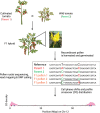Technology-driven approaches for meiosis research in tomato and wild relatives
- PMID: 36149478
- PMCID: PMC9957858
- DOI: 10.1007/s00497-022-00450-7
Technology-driven approaches for meiosis research in tomato and wild relatives
Abstract
Meiosis is a specialized cell division during reproduction where one round of chromosomal replication is followed by genetic recombination and two rounds of segregation to generate recombined, ploidy-reduced spores. Meiosis is crucial to the generation of new allelic combinations in natural populations and artificial breeding programs. Several plant species are used in meiosis research including the cultivated tomato (Solanum lycopersicum) which is a globally important crop species. Here we outline the unique combination of attributes that make tomato a powerful model system for meiosis research. These include the well-characterized behavior of chromosomes during tomato meiosis, readily available genomics resources, capacity for genome editing, clonal propagation techniques, lack of recent polyploidy and the possibility to generate hybrids with twelve related wild species. We propose that further exploitation of genome bioinformatics, genome editing and artificial intelligence in tomato will help advance the field of plant meiosis research. Ultimately this will help address emerging themes including the evolution of meiosis, how recombination landscapes are determined, and the effect of temperature on meiosis.
Keywords: Crossover; Genome editing; Genomics; Meiosis; Plant hybrids; Tomato.
© 2022. The Author(s).
Figures


Similar articles
-
A catalogue of recombination coldspots in interspecific tomato hybrids.PLoS Genet. 2024 Jul 1;20(7):e1011336. doi: 10.1371/journal.pgen.1011336. eCollection 2024 Jul. PLoS Genet. 2024. PMID: 38950081 Free PMC article.
-
Trait discovery and editing in tomato.Plant J. 2019 Jan;97(1):73-90. doi: 10.1111/tpj.14152. Epub 2018 Dec 24. Plant J. 2019. PMID: 30417464 Review.
-
CRISPR/Cas inactivation of RECQ4 increases homeologous crossovers in an interspecific tomato hybrid.Plant Biotechnol J. 2020 Mar;18(3):805-813. doi: 10.1111/pbi.13248. Epub 2019 Sep 30. Plant Biotechnol J. 2020. PMID: 31483929 Free PMC article.
-
Evidence of cryptic introgression in tomato (Solanum lycopersicum L.) based on wild tomato species alleles.BMC Plant Biol. 2012 Aug 7;12:133. doi: 10.1186/1471-2229-12-133. BMC Plant Biol. 2012. PMID: 22871151 Free PMC article.
-
Meiosis in crops: from genes to genomes.J Exp Bot. 2021 Sep 30;72(18):6091-6109. doi: 10.1093/jxb/erab217. J Exp Bot. 2021. PMID: 34009331 Free PMC article. Review.
Cited by
-
A catalogue of recombination coldspots in interspecific tomato hybrids.PLoS Genet. 2024 Jul 1;20(7):e1011336. doi: 10.1371/journal.pgen.1011336. eCollection 2024 Jul. PLoS Genet. 2024. PMID: 38950081 Free PMC article.
References
-
- Albini SM. A karyotype of the Arabidopsis thaliana genome derived from synaptonemal complex analysis at prophase I of meiosis. Plant J. 1994;5:665–672. doi: 10.1111/J.1365-313X.1994.00665.X. - DOI
MeSH terms
Grants and funding
LinkOut - more resources
Full Text Sources

